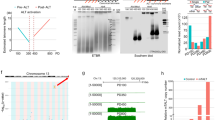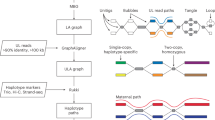Abstract
Telomere–associated chromosome fragmentation (TACF) is a new approach for chromosome mapping based on the non–targeted introduction of cloned telomeres into mammalian cells. TACF has been used to generate a panel of somatic cell hybrids with nested terminal deletions of the long arm of the human X chromosome, extending from Xq26 to the centromere. This panel has been characterized using a series of X chromosome loci. Recovery of the end clones by plasmid rescue produces a telomeric marker for each cell line and partial sequencing will allow the generation of sequence tagged sites (STSs). TACF provides a powerful and widely applicable method for genome analysis, a general way of manipulating mammalian chromosomes and a first step towards constructing artificial mammalian chromosomes.
This is a preview of subscription content, access via your institution
Access options
Subscribe to this journal
Receive 12 print issues and online access
$209.00 per year
only $17.42 per issue
Buy this article
- Purchase on Springer Link
- Instant access to full article PDF
Prices may be subject to local taxes which are calculated during checkout
Similar content being viewed by others
References
Barski, G., Sorieul, S. & Cornefert, F. Production dans des cultures in vitro de deux souches cellulaires en association, de cellules de caractere “hybride”. Compt. Rend. 251, 1825–1827 (1960).
Weiss, M. & Green, H. Human-mouse hybrid cell lines containing partial complements of human chromosomes and functioning human genes. Proc. natn. Acad. Sci. U.S.A. 58, 1104–1111 (1967).
Ruddle, F.H. Linkage analysis using somatic cell hybrids in Advances in human genetics (eds Harris, H. & Hirschhorn, K.) 3, 173–235 (Plenum Press, New York, 1972).
Human Mapping 11. Cytogenet. Cell Genet. 58 (1991).
McBride, O.W. & Ozer, H.L. Transfer of genetic information by purified metaphase chromosomes. Proc. natn. Acad. Sci. U.S.A. 70, 1258–1262 (1973).
Pritchard, C.A. & Goodfellow, P.N. Investigation of chromosome-mediated gene transfer using HPRT region of the human X chromosome as a model. Genes Devl. 1, 172–178 (1987).
Bickmore, W., Christie, S., van Heyningen, V., Hastie, N.D. & Porteous, D. Hitchhiking from Hras1 to the WAGR locus With CMGT markers. Nucl. Acids Res. 16, 51–61 (1988).
Goss, S.J. & Harris, H. New method for mapping genes in human chromosomes. Nature 255, 680–684 (1975).
Goss, S.J. & Harris, H. Gene transfer by means of cell fusion. J. cell Sci. 25, 17–37 (1977).
Goodfellow, P.N. Irradiation and fusion gene transfer. In Methods in Molecular Biology (ed. Murray, E.J.) 7, 53–61 (Humana Press, Clifton, New Jersey, 1991).
Benham, F. et al. A method for generating hybrids containing nonselected fragments of human chromosomes. Genomics 4, 509–517 (1989).
Cox, D.R., Burmeister, M., Price, E.R., Kim, S. & Myers, R.M. Radiation Hybrid Mapping: A somatic cell genetic method for constructing high-resolution maps of mammalian chromosomes. Science 250, 245–250 (1990).
Glaser, T., Rose, E., Morse, H., Housman, D. & Jones, C. A panel of irradiation-reduced hybrids selectively retaining human chromosome 11p13: their structure and use to purify the WAGR gene complex. Genomics 6, 48–64 (1990).
Goodfellow, P.J., Povey, S., Nevanlinna, H.A. & Goodfellow, P.N. Generation of a panel of somatic cell hybrids containing unselected fragments of human chromosome 10 by X-ray irradiation and cell fusion: Application to isolating the MEN2A region in hybrid cells. Somat. Cell molec. Genet. 16, 163–171 (1990).
Ceccherini, I. et al. Construction of a map of chromosome 16 by using radiation hybrids. Proc. natn. Acad. Sci. U.S.A. 89, 104–108 (1992).
Farr, C., Fantes, J., Goodfellow, P. & Cooke, H. Functional reintroduction of human telomeres into mammalian cells. Proc. natn. Acad. Sci. U.S.A. 88, 7006–7010 (1991).
Vollrath, D., Davies, R.W., Connelly, C. & Hieter, P. Physical mapping of large DNA by chromosome fragmentation. Proc. natn. Acad. Sci. U.S.A. 85, 6027–6031 (1988).
Capecchi, M.R. Altering the genome by homologous recombination. Science 244, 1288–1292 (1989).
Brown, C.J., Vivona, A., Parikh, S., Bedford, M. & Willard, H.F. Physical mapping of the human X chromosome by positive and negative counter-selection to generate broken chromosomes: “Pushmi-Pullyu” somatic cell hybrids. Cytogenet. cell Genet. 51, 970 (1989).
Luty, J.A. et al. Five polymorphic microsatellite VNTRs on the human X chromosome. Am. J. hum. Genet. 46, 776–783 (1990).
Nussbaum, R.L., Airhart, S.D. & Ledbetter, D.H. A rodent-human hybrid containing Xq24-Xqter translocated to hamster chromosome expresses the Xq27 folate-sensitive fragile site. Am. J. med. Genet. 23, 457–466 (1986).
Wieacker, P. et al. Toward a complete linkage map of the human X chromosome: regional assignment of 16 cloned single-copy DNA sequences employing a panel of somatic cell hybrids. Am. J. hum. Genet. 36, 265–276 (1984).
Litt, M. & Luty, J.A. A hypervariable microsatellite revealed by in vitro amplification of a dinucleotide repeat within the cardiac muscle actin gene. Am. J. hum. Genet. 44, 397–401 (1989).
Weber, J.L. & May, P.E. Abundant class of human DNA polymorphisms which can be typed using the polymerase chain reaction. Am. J. hum. Genet. 44, 388–396 (1989).
Hazan, J., Dubay, C., Pankowiak, M.P., Becuwe, N. & Weissenback, J. A genetic linkage map of human chromosome 20 composed entirely of microsatellite markers. Genomics 12, 183–189 (1992).
Olson, M., Hood, L., Cantor, C. & Botstein, D. A common language for the physical mapping of the human genome. Science 245, 1434–1435 (1989).
McClintock, B. The fusion of broken ends of sister half-chromatids following chromatid breakage at meiotic anaphases. Miss. Agric. Exp. Sta. Res. Bull. 290, 1–48 (1938).
McClintock, B. The significance of responses of the genome to challenge. Science 226, 792–801 (1984).
Smith, K.A., Stark, M.B., German, P.A. & Stark, G.R. Fusions neartelomeres occur very early in the amplification of CAD genes in Syrian hamster cells. Proc. natn. Acad. Sci U.S.A. 89, 5427–5431 (1992).
Toledo, F., Le Roscouet, D., Buttin, G. & Debatisse, M. Co-amplified markers alternate in megabase long chromosomal inverted repeats and cluster independently in interphase nuclei at early steps of mammalian gene amplification. EMBO J. 11, 2665–2673 (1992).
Cross, S.H. et al. The structure of a subterminal repeated sequence present on many human chromosomes. Nucl. Acids Res. 18, 6649–6657 (1990).
Kaster, K.R., Burgett, S.G., Rao, R.N. & Ingolia, T.D. Analysis of a bacterial hygromycin B resistance gene by transcriptional anf translational fusions and by DNA sequencing. Nucl. Acids Res. 11, 6895–6911 (1983).
Sambrook, J., Fritsch, E.F. & Maniatis, T. Molecular Cloning: a Laboratory Manual 2 edn (Cold Spring Harbor Laboratory Press, New York, 1989).
Feinberg, A.P. & Vogelstein, B. A technique for radiolabelling DNA restriction endonuclease fragments to high specific activity. Anal. Biochem. 137, 266–267 (1984).
Abbott, C. & Povey, S. Development of human chromosome-specfic PCR primers for the characterisation of somatic cell hybrids. Genomics 9, 73–77 (1991).
Theune, S., Fung, J., Todd, S., Sakaguchi, A.Y. & Naylor, S.L. PCR primers for human chromosomes: reagents for the rapid analysis of somatic cell hybrids. Genomics 9, 511–516 (1991).
Hermann, B.G., Barlow, D.P. & Lehrach, H. A large duplication allows homologous recombination between chromosomes heterozygous for the proximal t complex inversion. Cell 48, 813–825 (1987).
Michelson, A.M., Bruns, G.A.P., Morton, C.C. & Orkin, S.H. The human phosphoglycerate kinase multigene family. J. biol. Chem. 260, 6982–6992 (1985).
Lubahn, D.B. et al. The human androgen receptor: complementary deoxyribonucleic acid cloning, sequence analysis and gene expression in prostate. Molec. Endocrinol. 2, 1265–1275 (1988).
Cole, C.G., Goodfellow, P.N., Bobrow, M. & Bentley, D.R. Generation of novel sequence tagged sites (STSs) from discrete chromosomal regions using Alu-PCR. Genomics 10, 816–826 (1991).
Fisher, E.M.C. et al. Homologous ribosomal protein genes on the human X and Y chromosomes: escape from X inactivation and possible implications for Turner Syndrome. Cell 63, 1205–1218 (1990).
Brown, C.J. et al. A gene from the region of the human X inactivation centre is expressed exclusively from the inactive X chromosome. Nature 349, 38–44 (1991).
Ram, K.T., Barker, D.F. & Puck, J.M. Dinucleotide repeat polymorphism at the DXS441 locus. Nucl. Acids Res. 20, 1428 (1992).
Cremers, F.P.M., van de Pol, D.J.R., van Kerkhoff, L.P.M., Wieringa, B. & Ropers, H-H. Cloning of a gene that is rearranged in patients with choroideraemia. Nature 347, 674–677 (1990).
Stanier, P., Newton, R., Forbes, S.A., Ivens, A. & Moore, G.E. Polymorphic dinucleotide repeat at the DXS3 locus. Nucl. Acids Res. 19, 4793 (1991).
Hostikka, S.L. et al. Identification of a distinct type IV collagen a chain with restricted kidney distribution and assignment of its gene to the locus of X chromosome-linked Alport syndrome. Proc. natn. Acad. Sci. U.S.A. 87, 1606–1610 (1990).
Manoni, M. et al. The nucleotide sequence of a CpG island demonstrates the presence of the first exon of the gene encoding the human lysosomal membrane protein lamp2 and assigns the gene to Xq24. Genomics 9, 551–554 (1991).
Smets, D. & Arets, A. Genetic determination of fragile site expression. Am. J. hum. Genet. 47, 196–201 (1990).
Author information
Authors and Affiliations
Rights and permissions
About this article
Cite this article
Farr, C., Stevanovic, M., Thomson, E. et al. Telomere–associated chromosome fragmentation: applications in genome manipulation and analysis. Nat Genet 2, 275–282 (1992). https://doi.org/10.1038/ng1292-275
Received:
Accepted:
Issue Date:
DOI: https://doi.org/10.1038/ng1292-275
This article is cited by
-
Genetic and epigenetic effects on centromere establishment
Chromosoma (2020)
-
Stable mitotic inheritance of rice minichromosomes in cell suspension cultures
Plant Cell Reports (2015)
-
A pathway from chromosome transfer to engineering resulting in human and mouse artificial chromosomes for a variety of applications to bio-medical challenges
Chromosome Research (2015)
-
Engineered minichromosomes in plants
Chromosome Research (2015)
-
Minichromosomes and artificial chromosomes in Arabidopsis
Chromosome Research (2014)



